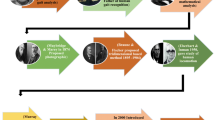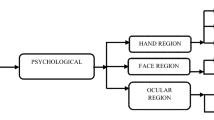Abstract
Gait is an identifying biometric feature. Video-based gait recognition has now become a new challenging topic in computer vision. In this paper, fractal scale wavelet analysis is applied to describe and automatically recognize gait. Fractal scale, which is based on wavelet analysis, represents the self-similarity of signals, and improves the flexibility of wavelet moments. It is translation, scale and rotation invariant, and has anti-noise and occlusion handling performance. Moreover, by introducing the Mallat algorithm of wavelet, it reduces the computation complexity. Experiments on three databases show that fractal scale has simple computation and is an efficient descriptor for gait recognition.













Similar content being viewed by others
References
Kale A, Sundaresan A, Rajagopalan AN, Cuntoor NP, Roy-Chowdhury AK, Krüger V, Chellappa R (2004) Identification of humans using gait. IEEE Trans Image Process 13(9):1163–1173
Cuntoor N, Kale A and Chellappa R (2003) Combining multiple evidences for gait recognition. In: Proceedings of the international conference on acoustics speech and signal processing, vol 3, pp 33–36
Kale A, Cuntoor N, Yegnanarayana B, Rajagopalan AN, and Chellappa R (2003) Gait analysis for human identification. In: Proceedings of the 3rd international conference on audio and video based person authentication, pp 706–714
BenAbdelkader C, Cutler R, and Davis L (2002) Motion-based recognition of people in EigenGait space. In: Proceedings of the 5th international conference on automatic face and gesture recognition, pp 254–259
Cutting J, Kozlowski L (1977) Recognizing friends by their walk: gait perception without familiarity cues. Bull Psychon Soc 9:353–356
Cutting J, Proffitt DR, Kozlowski LT (1978) A biomechanical invariant for gait perception. J Exp Psychol Human Percept Perform 4:357–372
Bobick AF, Johnson AY (2001) Gait recognition using static, activity-specific parameters. In: Proceedings of IEEE conference on computer vision and pattern recognition, pp 423–430
Lee L, Grimson WEL (2002) Gait appearance for recognition. In: Lecture notes in computer science, Proceedings of the international ECCV 2002 workshop copenhagen on biometric authentication, vol 2359, pp 143–154
Dockstader SL, Bergkessel KA, Tekalp AM (2002) Feature extraction for the analysis of gait and human motion. In: Proceedings of the 16th international conference on pattern recognition (ICPR’02), Quebec City, QC, Canada, pp 5–8
Dockstader SL, Tekalp AM (2002) A kinematic model for human motion and gait analysis. In: Proceedings of the workshop on statistical methods in video processing (ECCV), Copenhagen, Denmark, pp 49–54,
Hayfron-Acquah JB, Nixon MS, Carter JN (2001) Automatic gait recognition by symmetry analysis. In: Proceedings of the 2nd international conference on audio and video based person authentication, pp 272–277
Zhao G, Chen R, Liu G, Li H (2004) Amplitude spectrum-based gait recognition. In: Proceedings of the 6th international conference on automatic face and gesture recognition, pp 23–28
Collins RT, Gross R, Shi J (2002) Silhouette-based human identification from body shape and gait. In: Proceedings of the 5th international conference on automatic face and gesture recognition, pp 366–371
Wang L, Ning H, Hu W, Tan T (2002) Gait recognition based on procrustes shape analysis. In: Proceedings of the 9th IEEE international conference on image processing, Rochester, New York, pp 433–436
Huang PS (2001) Automatic gait recognition via statistical approaches for extended template features. IEEE Trans Syst Man Cybern B Cybern 31(5):818–824
BenAbdelkader C, Cutler R, Nanda H, Davis L (2001) EigenGait: motion-based recognition of people using image self-similarity. In: AVBPA, pp 284–294
Hu M (1962) Visual pattern recognition by moment invariants. IRE Trans Inf Theory IT 8:179–187
Little JJ and Boyd JE (1998) Recognising people by their gait: the shape of motion. Videre 1(2):2–32
Liu Y, Collins R and Tsin Y (2002) Gait sequence analysis using frieze patterns. In: European conference on computer vision, Copenhagen, pp 657–671
Shutler JD, Nixon MS (2001) Zernike velocity moments for description and recognition of moving shapes. BMVC, pp 705–714
Zhao G, Cui L, Xiang S, Li H (2005) Automatic gait recognition based on wavelet reflective symmetry moments. J Inf Comput Sci 2(2):421–428
Shen D, Ip HHS (1999) Discriminative wavelet shape descriptors for recognition of 2-D patterns. Pattern Recognit 32:151–165
Mallat A and Hwang WL (1992) Singularity detection and processing with wavelets. IEEE Trans Inf Theory 38(2):617–643
Stauffer C and Eric W L.Grimson, (2000) Learning patterns of activity using real-time tracking. IEEE Trans Pattern Anal Mach Intell 22(8):747–757
Daubechies I (1992) Ten lectures on wavelet, 2nd edn. Capital City, Montpelier
Kale A, Cuntoor N, Chellappa R (2002) A framework for activity-specific human identification. In: Proceedings of the international conference on acoustics, speech, and signal processing, vol 4, pp 13–17
Kale A, Rajagopalan A, Cuntoor N, Kruger V (2002) Gait-based recognition of humans using continuous HMMs. In: Proceedings of the international conference on automatic face and gesture recognition, pp 336–341
Lee L, Grimson W (2002) Gait analysis for recognition and classification. In: Proceedings of International Conference of Automatic Face and Gesture Recognition, pp 155–162
Sarkar S, Phillips PJ, Liu Z, Vega IR, Grother P, Bowyer KW (2005) The HumanID gait challenge problem: data sets, performance, and analysis. IEEE Trans Pattern Anal Mach Intell 27(2):162–177
Antonini M, Barlaud M, Mathieu P, Daubechies I (1992) Image coding using wavelet transform. IEEE Trans Image Process 1(2):205–220
Cheng Z (1998) Wavelet analysis algorithm and application. Xian Jiaotong University Press, Xian
Grauman K, Shakhnarovich G, Darrell T (2004) Virtual visual hulls: example-based 3D shape estimation from a single silhouette. AI Memo AIM-2004-003 Computer Science and Artificial Intelligence Laboratory Massachusetts Institute of Technology, Cambridge
Huttenlocher D, Klanderman D, and Rucklidge A (1993) Comparing images using the Hausdorff distance. IEEE Trans Pattern Anal Mach Intell 15(9):850–863
Phillips PJ, Sarkar S, Robledo I, Grother PJ, Bowyer KW (2002) The gait identification challenge problem: data sets and baseline algorithm. ICPR02, pp 385–388
Wang L, Tan T, Ning H, Hu W (2003) Silhouette analysis-based gait recognition for human identification. IEEE Trans Pattern Anal Mach Intell 25(12):1505–1518
Hew PC, Alder MD (1997) Recognition of printed digits using Zernike or orthogonal Fourier-Mellon moments. Perth, Western Australia, pp 1–11
Collins R, Gross R, and Shi J (2002) Silhouette-based human identification from body shape and gait. In: Proceedings of the International Conference on Automatic Face and Gesture Recognition, pp 366–371
Acknowledgments
The authors would like to thank University of South Florida and Dr. R. Gross from the Carnegie Mellon University for their help to provide the databases needed in the research. This work was supported by National High-Tech Research and Development Plan (grant No: 2001AA231031), National Key Basic Research Plan (grant No: 2004CB318000) and National Special R&D Plan for Olympic Games (grant No: 2001BA904B08).
Author information
Authors and Affiliations
Corresponding author
Rights and permissions
About this article
Cite this article
Zhao, G., Cui, L. & Li, H. Gait recognition using fractal scale. Pattern Anal Applic 10, 235–246 (2007). https://doi.org/10.1007/s10044-007-0064-z
Received:
Accepted:
Published:
Issue Date:
DOI: https://doi.org/10.1007/s10044-007-0064-z




